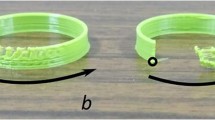Abstract
Hybrid Manufacturing combines the advantages of Additive Manufacturing (AM) and Subtractive Manufacturing on a single machine. Although previous research has provided a good background of the manufacturing parameters, the analysis is often carried out separately and there is a lack of combined knowledge. The purpose of this research is to examine the influence of the main manufacturing parameters involved in AM and subtractive processes using different variables. Particularly, the study is focused on the Material Extrusion process concerning the layer height, fill angle and fill density; as well as two factors related to machining, including stepover and pass direction. The parameters that were examined include the dimension, hardness, flatness, weight and roughness. A multifactorial Design of Experiments was proposed with a total of 64 samples. Next, a statistical analysis was carried out to assess the influence of the different groups on the response variables. Finally, a decision table presented and facilitated the selection of parameters depending on the desired objectives, leading to a framework that was applied to a case study for validation. This decision guide could enable designers and engineers to select the best strategy for a specific application, leading to a more efficient approach for manufacturing.










Similar content being viewed by others
References
Chohan JS, Singh R (2017) Pre and post processing techniques to improve surface characteristics of FDM parts: a state of art review and future applications. Rapid Prototyp J 23(3):495–513
Maidin S, Muhamad MK, Pei E (2015) Experimental setup for ultrasonic-assisted desktop fused deposition modeling system. Appl Mech Mater 761:324–328
Yamazaki T (2016) Development of a hybrid multi-tasking machine tool: integration of additive manufacturing technology with CNC machining. Procedia CIRP 42:81–86
Lorenz KA, Jones JB, Wimpenny DI, Jackson MR (2015) A review of hybrid manufacturing. In: Solid Freeform Fabrication Symposium (SFF), Austin, TX, Aug, 10–12
Seidel A et al (2018) Added value by hybrid additive manufacturing and advanced manufacturing approaches. J Laser Appl 30:032301
Du W, Qian B, Bi Z (2016) A novel method for additive/subtractive hybrid manufacturing of metallic parts. Procedia Manuf 5:1018–1030
Chu W-S, Kim C-S, Lee H-T, Choi J-T, Park J-I, Song J-H, Jang K-H, Ahn S-H (2014) Hybrid manufacturing in micro/nano scale: a review. Int J Precis Eng Manuf Green Technol 1(1):75–92
Prashanth R, Panos SS, Avinash DT (2017) Analyzing the effects of temperature nozzle-bed distance and their interactions on the width of fused deposition modelled struts using statistical techniques toward precision scaffold fabrication. J Manuf Sci Eng 139(7):071007-1–071007-9
Nowicki M, Castro N, Plesniak MW, Zhang LG (2016) 3D printing of novel osteochondral scaffolds with graded microstructure. Nanotechnology 27(41):414001
Lanzotti A, Grasso M, Staiano G, Martorelli M (2015) The impact of process parameters on mechanical properties of parts fabricated in PLA with an open-source 3-D printer. Rapid Prototyp J 21(5):604–617
Gordeev EG, Galushko AS, Ananikov VP (2018) Improvement of quality of 3D printed objects by elimination of microscopic structural defects in fused deposition modeling. PLoS ONE 13(6):e0198370
Author information
Authors and Affiliations
Corresponding author
Rights and permissions
About this article
Cite this article
Paz, R., Santamarta, J., Monzón, M.D. et al. An analysis of key process parameters for hybrid manufacturing by material extrusion and CNC machining. Bio-des. Manuf. 1, 237–244 (2018). https://doi.org/10.1007/s42242-018-0023-0
Received:
Accepted:
Published:
Issue Date:
DOI: https://doi.org/10.1007/s42242-018-0023-0




